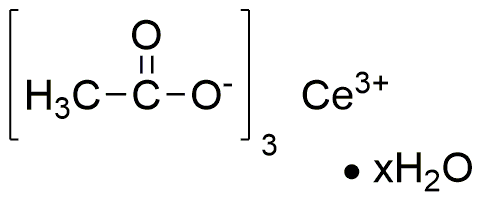Cerium(III)acetate hydrate is widely utilized in research focused on:
- Catalysis: This compound serves as an effective catalyst in various organic reactions, enhancing reaction rates and improving yields in the synthesis of fine chemicals.
- Material Science: It is used in the development of advanced materials, particularly in the production of cerium oxide nanoparticles, which have applications in electronics and optics.
- Environmental Remediation: Cerium(III)acetate hydrate plays a role in the removal of pollutants from wastewater, aiding in the degradation of organic contaminants.
- Biomedical Applications: Researchers are exploring its potential in drug delivery systems and as an antioxidant, which can help in reducing oxidative stress in biological systems.
- Glass and Ceramics: This compound is utilized in the glass industry to improve the durability and optical properties of glass products, making them more resistant to scratches and thermal shock.
General Information
Properties
Safety and Regulations
Applications
Cerium(III)acetate hydrate is widely utilized in research focused on:
- Catalysis: This compound serves as an effective catalyst in various organic reactions, enhancing reaction rates and improving yields in the synthesis of fine chemicals.
- Material Science: It is used in the development of advanced materials, particularly in the production of cerium oxide nanoparticles, which have applications in electronics and optics.
- Environmental Remediation: Cerium(III)acetate hydrate plays a role in the removal of pollutants from wastewater, aiding in the degradation of organic contaminants.
- Biomedical Applications: Researchers are exploring its potential in drug delivery systems and as an antioxidant, which can help in reducing oxidative stress in biological systems.
- Glass and Ceramics: This compound is utilized in the glass industry to improve the durability and optical properties of glass products, making them more resistant to scratches and thermal shock.
Documents
Safety Data Sheets (SDS)
The SDS provides comprehensive safety information on handling, storage, and disposal of the product.
Product Specification (PS)
The PS provides a comprehensive breakdown of the product’s properties, including chemical composition, physical state, purity, and storage requirements. It also details acceptable quality ranges and the product's intended applications.
Certificates of Analysis (COA)
Search for Certificates of Analysis (COA) by entering the products Lot Number. Lot and Batch Numbers can be found on a product’s label following the words ‘Lot’ or ‘Batch’.
*Catalog Number
*Lot Number
Certificates Of Origin (COO)
This COO confirms the country where the product was manufactured, and also details the materials and components used in it and whether it is derived from natural, synthetic, or other specific sources. This certificate may be required for customs, trade, and regulatory compliance.
*Catalog Number
*Lot Number
Safety Data Sheets (SDS)
The SDS provides comprehensive safety information on handling, storage, and disposal of the product.
DownloadProduct Specification (PS)
The PS provides a comprehensive breakdown of the product’s properties, including chemical composition, physical state, purity, and storage requirements. It also details acceptable quality ranges and the product's intended applications.
DownloadCertificates of Analysis (COA)
Search for Certificates of Analysis (COA) by entering the products Lot Number. Lot and Batch Numbers can be found on a product’s label following the words ‘Lot’ or ‘Batch’.
*Catalog Number
*Lot Number
Certificates Of Origin (COO)
This COO confirms the country where the product was manufactured, and also details the materials and components used in it and whether it is derived from natural, synthetic, or other specific sources. This certificate may be required for customs, trade, and regulatory compliance.

